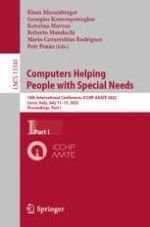
Open Access 2022 | OriginalPaper | Buchkapitel
Impact of Using an Eye-Gaze Technology by a Young Adult with Severe Cerebral Palsy Without Speech
verfasst von : Yu-Hsin Hsieh, Mats Granlund, Ai-Wen Hwang, Helena Hemmingsson
Erschienen in: Computers Helping People with Special Needs
Aktivieren Sie unsere intelligente Suche, um passende Fachinhalte oder Patente zu finden.
Wählen Sie Textabschnitte aus um mit Künstlicher Intelligenz passenden Patente zu finden. powered by
Markieren Sie Textabschnitte, um KI-gestützt weitere passende Inhalte zu finden. powered by